 |
| The Independent Traveler's Newsletter PAGE TWO |
 |
| The Independent Traveler's Newsletter PAGE TWO |
| ICI ET LÀ |
|
in France or France-related events taking place in the United States & elsewhere between now and the publication of our next issue. In France. . . 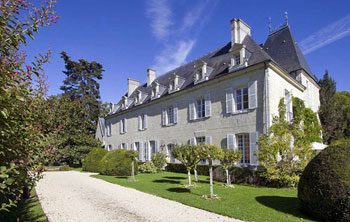 o We want to tell you about this unusual opportunity: Château de Détilly in the Loire has a special offer to rent the château from July 12 to July 22, 2017, at a 38% reduction in their rate. Détilly can accommodate 25 people very comfortably in the château and coach house, and guests will enjoy the beautiful swimming pool and tennis court as well as the use of a two kitchens. Wine tastings and cooking courses can be arranged, and the château is the perfect venue for a beautiful wedding with its own chapel. The special discounted rate, normally €24,000 for these high season dates, is €15,000 for the 10 days. Send an email today to ask any questions you might have or to book your reservation. 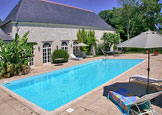 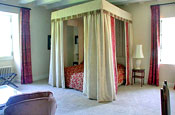 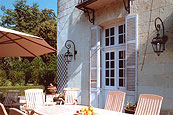 o Disneyland Paris is celebrating its 25th anniversary, marking the occasion with new attractions and a re-imagined daytime parade, as well as a night time show and makeovers of the traditional rides. Several of the resort hotels have completed renovations, and Le Château de la Bell au Bois Dormant has achieved 4-star status. The Celebrations begin March 26th. For more details please visit www.disneylandparis.fr. 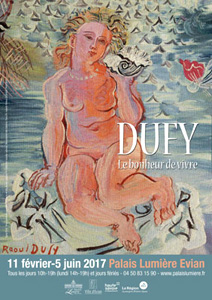 o The Petit Palais in Paris will exhibit over two hundred 18th century French paintings, sculptures and drawings from the collection of American Jeffrey Horvitz until July 16th. More at www.petitpalais.paris.fr. o Raoul Dufy, Le Bonheur de Vivre (the Joy of Living), will run through June 5th in at the Palais Lumière in Evian, France. The exhibition represents the artist's brilliant work and his love of nature and freedom. Details about this exhibit can be found at www.ville-evian.fr or www.palaislumiere.fr. o Summer of 2017 is the time scheduled for the reopening of the Franco-American Museum at the Château de Blérancourt in Picardy in Northern France. After a 4.5 million euro renovation, including the uncovering of some important archeological remains, the museum is getting ready to welcome visitors. During World War I, Anne Morgan, daughter of American financier John Pierpont Morgan, established headquarters in the château to help the war-ravaged civilian population. When the war ended, Anne purchased the château opening part of it as a Franco-American museum emphasizing the long cooperation between the two countries. There will be both temporary and permanent exhibits. Many people contributed to make this a reality including the French Ministry of Culture & Communication, the Florence Gould Fund by the American Friends of Blérancourt, and philanthropic donations from the United States. It is an important reminder that American and France have always been allies and have a special bond. Learn more at www.museefrancoamericain.fr. 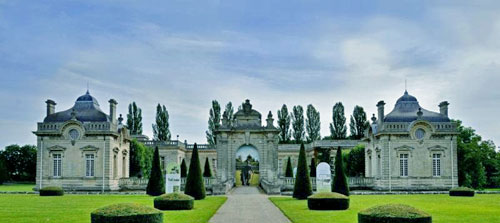 Château de Blérancourt o The Musée d'Art Moderne André Malraux in Le Havre will host the exhibit Jacqueline Salmon: du vent, du ciel, et de la mer (Wind, Sky and the Sea) through the 23 of April 2017. For more information visit www.muma-lehavre.fr. o Learn French in Paris with French à La Carte. Private lessons in your home, office or while you are exploring the city. French à la Carte offers lessons for beginners, children, or business French, conversational French and French for Lovers of Paris. . . and more! Visit their very informative web site at http://www.private- o One of the biggest Impressionist collections outside of Paris is at the Fine Arts Museum in Rouen, Normandy, With paintings, sculpture, drawings and more from the past 500 years, don't miss the opportunity to visit. A temporary Picasso exhibition is from April to September of 2017. More details at www.mbarouen.fr/. o The La Rochelle Aquarium will hold an important exhibition this year concerning loss of coral reefs around the world. The aquarium is a research, training and learning center whose goal is to educate the public in methods of marine conservation. To learn more visit www.aquarium-larochelle.com.
DID YOU
KNOW? The
magnificent Château
de Vaux-le-Vicomte, constructed from 1658 to 1661 for Nicolas
Fouquet, the Superintendent of finances for Louis XIV,
that was designed by architect Louis le Vau and had gardens designed by landscape architect André le Nôtre, led to Fouquet's lifetime imprisonment? After a 3-year long trial, the young King had Fouquet banished for the remainder of his life to a prison in Pignerol, Italy, where he died in 1680 at the age of 65 ~ all because the château confirmed the King's suspicions that Fouquet was outrageously extravagant, had accumulated great wealth and seemed far too ambitious. The King later hired both le Vau and le Nôtre to create his palace at Versailles. Some say jealousy of Fouquet was behind it all. In the US and Canada . . . o Art and Nature in the Middle Ages is the exhibit through March 19 at the Dallas Museum of Art. Organized by the Musée de Cluny in Paris, the show depicts the great migrations in Europe during the 5th, 6th and 7th centuries when Islamic and Eastern art forms influenced Medieval artisans. This is the only US showing of this exhibit. More information at www.dma.org.o Bouchardon: Royal Artist of the Enlightenment is the exhibit through April 2 at the Getty Center in Los Angeles. Bouchardon sculpted an enormous bronze of Louis XV on horseback that adorned the Place de Concorde until the French Revolution when it was removed and melted down. Only one hand remains, and the famed Luxor Obelisk took its place. The artist was a link between the Rococo and Neoclassical periods, and there is now a retrospective of his work at the Louvre. More details at www.getty.edu. o Through April 16 the Portland Art Museum in Oregon will host Rodin: The Human Experience ~ Selections from the Iris and B. Gerald Cantor Collections. Fifty-two bronzes representing highlights of the artist's career will be on display. Featured will be The Burghers of Calais and monuments to honor Victor Hugo and Honoré de Balzac. Visit www.portlandartmuseum.org. o Providence, Rhode Island's museum at the Rhode Island School of Design will host Inventing Impressionism until June 11, exploring the origins of that favorite Western art movement. There will be paintings by Monet, Pissarro, Renoir and others revealing each artists unique contributions to this style. Highlights include Dégas' monumental pastel Six Friends at Dieppe. More information at www.risdmuseum.org. o Chagall: Color and Music is the title exhibit through June 11 at the Montreal Museum of Fine Arts. Some 400 works of the artist including paintings and puppets reflect his upbringing in his native Belarus. Music was a big influence on his life and art, so musical instruments appear in many of his compositions. There are works dedicated to the performing arts including wall panels for the Jewish Theatre in Moscow, murals for the Metropolitan Opera House in New York, and the vast ceiling of Paris' Opera Garnier. For details visit www.mbam.qc.ca. o Matisse and American Art examines the artist's influence on Modern Art in the United States. His works are shown with those of American artists such as Lichtenstein, Warhol and Prendergast among others. The show runs through June 18 at the Montclair Museum in Montclair, New Jersey. See details at www.montclairartmuseum.org. o Honoring the 100th anniversary of the death of Auguste Rodin, the Rodin Centenary will run through December 31, 2017, at San Francisco's Legion of Honor. For further information please visit www.famsf.org. BY THE SEA continued . . . The Vendée 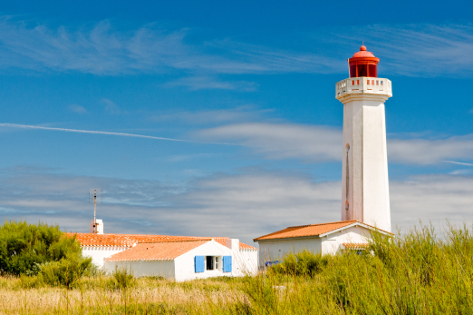
Île d'Yeu
From the mainland end of the bridge, you can take a ferry to the rocky and windswept L'Île-d'Yeu to visit its lighthouse or La Citadelle de Pierre - Levée. Plan to get around by bicycle as the roads are too narrow for cars. There are some nice beaches facing the mainland, but the other side of the island is steep and rocky. The ferry trip takes about 2 hours, and the island offers bed and breakfasts, small hotels and self-catering accommodations. This photo is the Corbeaux Lighthouse on Île d'Yeu. Return to the mainland and follow the D38 southward to St-Jean-de-Monts. This is a town we remember being rather small and unassuming in the early '90s -- but in the 21st century it has become an amazing beach resort. Apartment buildings and shops line the street along the coast divided from the water by a nice promenade. The beach is very broad with lovely sand and warm surf -- a popular vacation spot for obvious reasons. St-Jean-de-Monts is nearly in the center of the Forêt de Pays de Monts, a pine forest that stretches from the bridge leading to Noirmoutier southward to beachfront Croix, some twenty-five kilometers. Down the
coast is Les
Sables-d'Olonne,
a large seaside resort on the Côte de la Lumière
(the Light Coast) with a beach that is nearly 2 miles long.
Summer
festivals
bring out the locals, said to be the descendants of the Moors driven
from
Spain, in folk costumes. The town offers a museum dedicated to
the
Vendéen Wars, the Musée
de l'Abbaye Ste-Croix founded in
the 17th century by Benedictine monks and now a museum of contemporary
art as well as prehistory, and the
Église Notre-Dame-de-Bon-Port
built in 1646 by Richelieu.
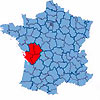 THE CHARENTE-MARITIME THE CHARENTE-MARITIME
If you want to see the largest marshes in France, leave Les Sables on the D949 direction Luçon -- you will be in the heart of the Marais Poitevin. There are many opportunities to stay at chambres d'hôtes in this peaceful land of canals, or you can continue southward to nearby La Rochelle [photo at right], a well-loved fortified port city. Once there you will understand why artists, writers and tourists alike are drawn to it and why it is the third most visited city in France! The site of religious conflict in the 1600s ~ on one occasion Cardinal Richelieu against Jean Guiton ~ La Rochelle has a rich and interesting thousand years of history. Walkers
will especially appreciate La Rochelle's old town which is paradise for
pedestrians. Houses there, the oldest in half-timbering
with
slate overhangs, were built with two entrances ~ one
on the street and one on a lane parallel ~ and most had interior
courtyards.
A maze of cobbled streets and archways, hidden alleys and vaulted
secret passages all create the atmosphere of which Guy de Maupassant
wrote, "...the
setting for a conspiracy, a captivating backdrop for the wars of bygone
days. . . " The entrance to the old port is 'guarded' by two
famous towers, Tour de la Chaine and
Tour St-Nicolas ~ the
pair have
become
symbolic of the city. A third tower, Tour de Lanterne, is to the
west of Tour de la Chaine and
has a distinct conical roof. With regard to dining in La
Rochelle, as
you can imagine, most of the restaurants specialize in food from the
sea,
fresh local produce and primarily local wines. Where to stay:
Le Clos de la
Garenne in Puyravault offers charming B&B rooms, a
self-catering gîte and an
apartment with disabled access. It is convenient to the coastal towns of Rochefort and La Rochelle, historic Surgères and the inland cities of Saintes and Cognac, as well as the islands of Île de Ré and Île de Noirmoutier.
Take time to visit yet another large island -- this one is the Île de Ré, probably one of the most popular resort islands attracting French families and just a stone's throw from La Rochelle over an amazing 2 mile long curved toll bridge, Pont-Viaduc. (The toll to reach the island is between €9 and €16.50 depending upon the time of year. Return is toll free.) With a Mediterranean climate, you will once again find whitewashed houses and great expanses of sandy beach, gardens filled with hollyhocks, the fragrance in the air of rosemary, and lovely small waterfront villages. Cycling is popular on the island and encouraged for exploring the island and marshlands on over 87 kilometers of bike routes. Saint-Martin-de-Ré (photo below right) facing the Pertuis Breton bay is a picture postcard village in existence since the Middle Ages. As we said, the island is Mediterranean in climate, so summer visitors may experience hotter than expected temperatures. 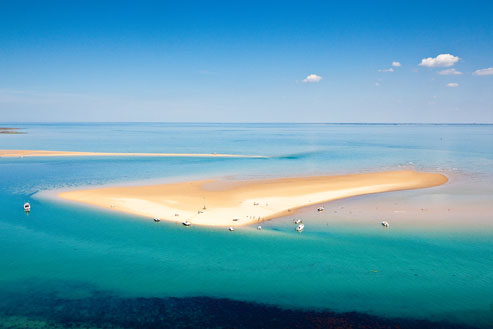 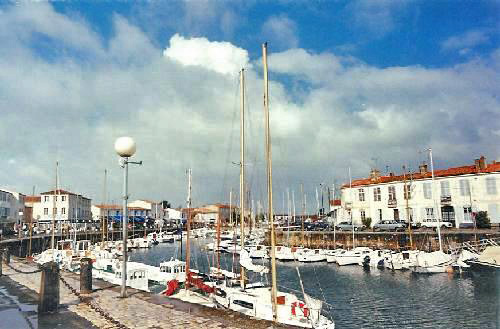
Pont du Fier sand bar on Île de
Ré
Saint-Martin-de-Ré
Farther
south and inland from the coast on the River Charente is the city of Rochefort,
famous for its architecture and the Corderie Royale where hemp ropes
were
twisted, now a museum. Rich and ornate façades adorn
mansions, and its wealth of museums draws visitors year 'round.
And, it is now the home port for L'Hermione,
the exact replica of General Marquis de Lafayette's French frigate that
brought him to the American shore during the Revolutionary War.
Île d'Oléron
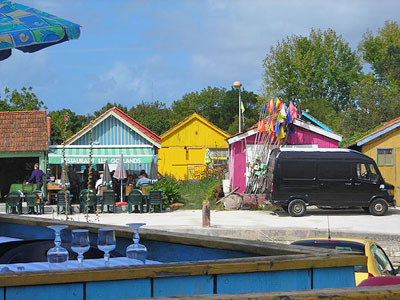 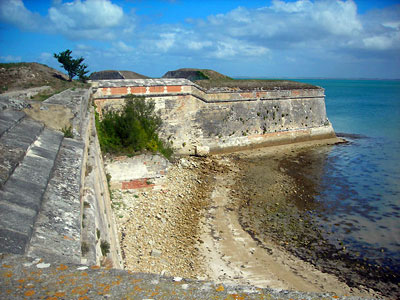 The
D733 / D123 from Rochefort in the direction of Marennes will bring you
to the Île
d'Oléron,
the largest of all French islands after Corsica ~ and France's
oyster
capital.
With exceptional sand dunes lining its shores and charming houses
surrounded by flower gardens, the island is a pleasure to visit.
In addition to oyster beds, visitors will discover windmills and
vineyards producing distinctive rosé and
white
wines.
On the island's Côte Sauvage (Wild Coast), the locals go
spear
fishing in the spring and autumn. The
D733 / D123 from Rochefort in the direction of Marennes will bring you
to the Île
d'Oléron,
the largest of all French islands after Corsica ~ and France's
oyster
capital.
With exceptional sand dunes lining its shores and charming houses
surrounded by flower gardens, the island is a pleasure to visit.
In addition to oyster beds, visitors will discover windmills and
vineyards producing distinctive rosé and
white
wines.
On the island's Côte Sauvage (Wild Coast), the locals go
spear
fishing in the spring and autumn. The island is very popular for visits to the fortress, the bird marshes, and the lighthouse. We especially enjoyed the village of Château d'Oléron [photo at right] with its little family-owned restaurants and brightly painted cottages along the canal. Steps from this village is the citadel [photo left] whose construction began in 1630 on the orders of Cardinal Richelieu to help protect France's Atlantic Coast. Built where an 11th century fortress castle once stood, it was declared a Monument Historique in 1929.
continued on page 3
|
 previous
page
next page
previous
page
next page  |